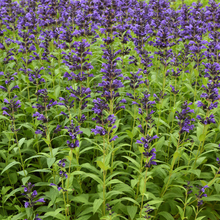Nepeta 'Purple Prelude' is a compact early blooming catmint selected for its deep lavender flowers and mounding growth habit. It begins flowering earlier than most nepeta varieties and continues well into summer. The aromatic gray green foliage deters deer and rabbits while attracting a wide variety of pollinators to the garden. Its tidy size makes it ideal for edging, containers, and small space plantings.
Height & Spread: 12 - 14 in x 18 - 24 in
Bloom Time: Late spring to midsummer
Light Requirements: Full sun
Soil Preference: Well drained, average to dry soil
Watering Needs: Low once established
Deer Resistance: Highly resistant due to aromatic oils in leaves
Native Status
Nepeta 'Purple Prelude' is a cultivated selection derived from Nepeta species native to Europe and Asia. It is not native to North America but is widely used in ornamental and pollinator gardens.
WILDLIFE & INSECTS
Bees
- Highly attractive to honeybees, bumblebees, and small native solitary bees due to its continuous bloom and rich nectar.
Butterflies
- Frequently visited by Painted Ladies, Skippers, and other summer butterflies seeking nectar sources.
Moths
- Draws day flying moths such as the Hummingbird Clearwing as well as nocturnal species during twilight hours.
Spacing & Landscape Use
Spacing Recommendations:
- Space 18 - 24 in apart to allow for healthy airflow and natural clump expansion.
Landscape Placement:
- Ideal for sunny borders, edging pathways, rock gardens, and container designs needing fragrance, texture, and soft color contrast.
Companion Plants
- Lavandula angustifolia 'Hidcote' - Deep purple flower spikes pair well with catmint and offer long lasting fragrance and structure.
- Coreopsis verticillata 'Moonbeam' - Soft yellow daisies contrast with purple blooms and bring extended summer color.
- Calamintha nepeta 'White Cloud' - Clouds of tiny white flowers soften borders and echo nepeta’s relaxed form.
- Achillea millefolium 'Paprika' - Warm red blooms form a bright accent and tolerate similar dry, sunny conditions.
- Salvia nemorosa 'May Night' - Compact violet spires provide continuity of color and attract similar pollinators.



